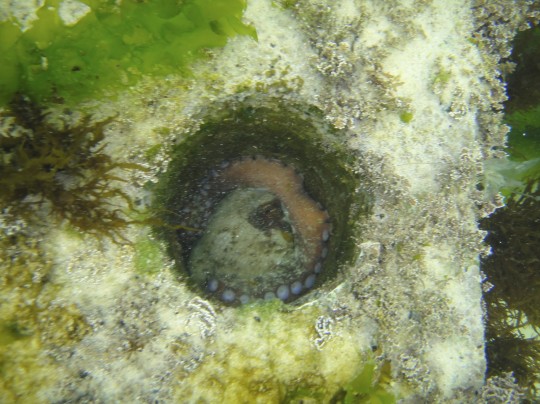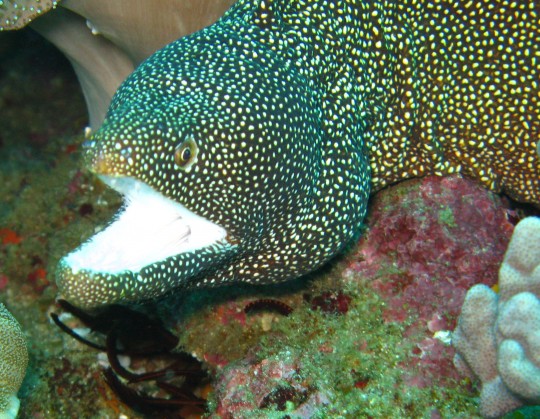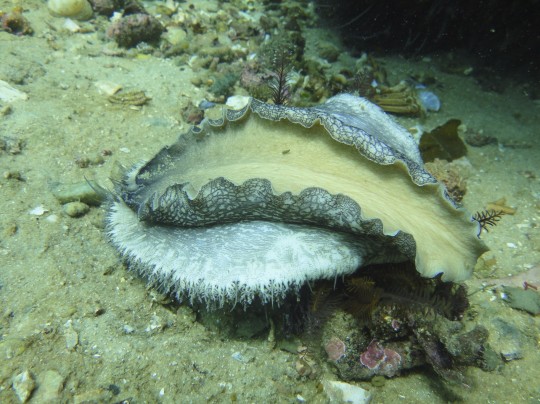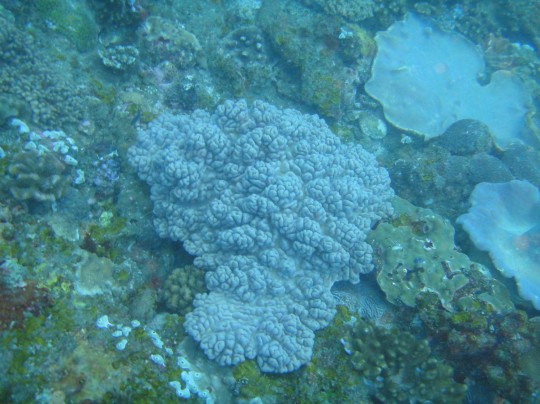
Dive date: 17 April 2011 Air temperature: 23 degrees Water temperature: 23 degrees Maximum depth: 12.8 metres Visibility: 20 metres Dive duration: 53 minutes

Dive date: 17 April 2011 Air temperature: 23 degrees Water temperature: 23 degrees Maximum depth: 12.8 metres Visibility: 20 metres Dive duration: 53 minutes

Tony gave me this book out of his collection when I was lying in bed with a cold, needing entertainment. It’s hard to pinpoint the genre. The best part of the book is the magnificent photography by Alexander Mustard – not all of his pictures are to my taste (I don’t much like motion blur) but in general his contribution is magnificent.
The text deals with the history of scuba diving, as well as tips for improving your skills. These can be distilled into relax, slow down your breathing, and swim slower! Hanna meditates on different sea creatures that have been demonised in literature and film – sharks, rays, octopus, moray eels – and shows how these perceptions are wrong. Michael Rutzen, South Africa’s own shark man who free dives with great whites (when a very precise set of conditions are met – he’s extremely careful) also gets a mention.
Hanna also discusses the merits of touching sea creatures, and acknowledges that a complete prohibition may be the best thing given that not all divers have the knowledge and experience to determine when it’s a good idea to reach out or not. He does mention that many creatures, such as morays and groupers (e.g. potato bass) appear to actively enjoy the interaction.
Later sections of the book talk about the intersection of yoga with diving, the practice of yoga before and during dives, and an alleged PADI specialty called Mind, Body and Spirit (MBS) diving which advocates a more meditative approach (only available in the Carribbean – like they need it there!). I am prepared to acknowledge that (perhaps of necesstity – one tank full of air goes further than a lungful) our freediving friends get this right more often than us scuba junkies. Hanna talks about being more mindful underwater, cultivating an attitude of playfulness, and gives suggestions for changing one’s perspective when diving gets too much like a chore. I really liked this section of the book!
The section on free diving is beautifully written and illustrated, and even though the sport doesn’t appeal to me at all, I can see the magic of being so free to move, having to listen so closely to one’s body, and being able to interact silently with creatures who’d be scared away by scuba.
The authors’ official website for the book is here. You can order the book here or here.
This information could possibly used to certify me insane, but I will risk it.
Very little research has been done about this but I (as have many others) have always believed that different creatures begin to warm to divers. There are many stories of specific ocean creatures being named, recognised and often visited by many divers.
Several octopus at Long Beach for example live in holes on the pipeline and no matter what if you go by in the day they will be there.

Often, on night dives,there is no one home as they are off feeding, probably close by, but due to the darkness we don’t see them. This is how they move around at night.
[youtube=http://www.youtube.com/watch?v=mAL6Nld69vI&w=540]
Sodwana Bay had a brindle bass, seen by many divers year after year at the same dive site. This huge creature was very friendly and enjoyed interacting with divers. Many creatures in the ocean are fiercely territorial and once you have found them and discovered their territory it is easy to spot them as they seldom go far.

Whilst working in Mozambique I too visited the same reef sometimes four or five times a day on a busy weekend, showing different groups of divers the same ”locals” on the reef.
[youtube=http://www.youtube.com/watch?v=vyq6qcByx6A&w=540]
This video shows a huge potato bass that I believed was always waiting for us to drop in. This potato bass is easily recognizable by the fact that she has only one eye. You could not just swim past without giving her a tickle as doing so would result in her following the group all down the reef. Ascending to the safety stop you would see her race back to the start of the reef where she knew the next group would be dropped.
I am convinced of this as on the odd occasion that the weather would present us with a reverse current, we would drop down on the opposite end of the reef and there she would be.
“They bite” is what any diver will tell you. Well they do, however I believe this particular black cheeked eel warmed to me. I visited her every day for about six months. The first few weeks I just looked, then the next few weeks I offered my hand, it got bitten, severely several times and the resulting injuries required a few weeks of looking only. From this video clip, heavily edited, its clear the aggression shown in the first few weeks waned, became less severe, and eventually slowed right down to a nibble without breaking the skin… Was she warming, becoming more friendly or just getting so tired of my annoying hand in her face that she didn’t want to bother? You decide.
[youtube=http://www.youtube.com/watch?v=ti4xoPWSztU&w=540]
A rather large honeycomb moray also fond of a chin tickle:

The reason for the preceding information is to justify my fondness for two little fellas I met at Long Beach while Kate was doing her Zero to Hero course. They are called Peanut (a juvenile double sash butterflyfish) and Butter (a juvenile jutjaw).

I first spotted them a couple of months back and every time I go by on a dive I take a peek to see if they are still there. Being as small as they are there is a real risk they may end up as lunch for someone, but for now we will monitor their progress and watch them grow.
Tony and I are getting a little nephew soon (thanks to my sister and brother in law for doing the work), and I am making him a present for his bedroom wall. It’s a marine alphabet… Hopefully he’ll love the sea, as well as guitars and words (when his parents are done with him)!






There is always a lot of opinion from divers on the “touch or don’t touch” issue and so often it is the photographers who have the most to say. These are the people who will sprawl themselves out on the sand in order to “protect the reef”, totally unaware of the multitude of creatures that live just below the sand’s surface. They will advocate… DONT TOUCH loudly but will blind a creature repeatedly with huge strobes in the interest of getting the shot. These creatures may not be able to see for several minutes after this blinding flash and could quite easily be eaten the second you move off.
I am a freelance instructor and love the ocean. I am not an expert in any particular aspect of diving so when I don’t have students I dive for pleasure. Occasionally with a camera, occasionally with a small video camera and I occasionally touch the wildlife.
We all have our own opinions mostly based on our own experiences and the campfire stories we tell and listen to. Should we touch or should we not? I believe that if the creatures want to be touched you will be able to, and if they don’t want you near them it just won’t happen. This excludes sudden grabbing… This must be avoided. If a creature in the ocean allows you to approach slowly, suddenly reaching out and grabbing it is definitely a no no.
This is a video clip of a black cheek moray taken over several months. I visited this eel almost every day while working in Mozambique, and sometimes several times a day for six months. I offered my gloved hand and on day one got bitten… sore… by the third month this black cheek still tried to bite me occasionally, but it was far more gentle and sometimes she just rubbed her head on my hand.
[youtube=http://www.youtube.com/watch?v=ti4xoPWSztU&w=540]
A honeycomb moray I also visited almost daily would lift her head for a rub and if you took your hand away she would nod her head up and down until you stroked her chin again.

This potato bass would follow you around on a dive until you rubbed her chin. If you ignored her she would bump you several times to get your attention.
[youtube=http://www.youtube.com/watch?v=vyq6qcByx6A&w=540]
Klipfish at Long Beach are also often friendly and will sit in your hand if you stay still, make slow and gentle advances and don’t try to grab them.

This klipfish has a wound and over the last few weeks we have seen the wound heal slowly. A fish with such an injury would be expected to be jumpy, but not so, it is almost as if she comes close to show you, as I have seen this fish numerous times.
I was on a dive in Durban on a wreck called Coopers Light Wreck, an unknown wreck named after the Cooper lighthouse. Wrecks around Durban are popular fishing sites so there is always a fair amount of fishing line and tackle on the wrecks.
We discovered a moray eel tangled in fishing line. This eel had wriggled so much in an effort to free herself that she was almost dead from exhaustion plus a section of her midriff was white where the line had peeled her skin off. I had a knife so two other divers held her whilst I cut through the line.
This eel was so injured but still kept trying to bite the line off. Having succeeded with most of it she was still tied in a loop of stainless steel wire trace. Fortunately most dive knives have a serrated edge so I was able to saw through this but as the other divers let her go she bit onto my hand and just gently seemed to be holding on whilst I cut the last strands. Once free she swam down to a hole I presumed to be home, stopped and took a look back at me, making me feel honored at being able to save her life.

From time to time we see sharks, large fish and other creatures with hooks in their mouths – having bitten onto a “tasty meal” the hook is embedded deeply in their flesh. They fight and sometimes get loose, but the hook stays. If its a steel hook it rusts away quickly, but lately stainless steel is widely used and these hooks stay forever.
This blog post recently came to my attention – it’s by Burt Jones and Maurine Shimlock, and in it they talk about why touching marine life is a bad idea. I agree that, as a rule, it is a bad idea, but I don’t think it’s always totally out of the question.
Restoration
I must confess that when I see an upside down starfish, crab, or abalone, I turn them back over. Call it interfering with the natural order of things, but I can’t swim by and leave them. I know how uncomfortable I feel when I get stuck somewhere in an awkward position, and I just have to help!

Assisting an injured or entangled animal
A creature that is entangled with fishing line, or has a fish hook in its mouth, for example, is dealing with something completely outside of what nature intended for it to experience. If the animal allows, I think it’s totally appropriate to assist. In the case of a whale, a shark, or a creature that could potentially hurt you (possibly just by virtue of its vast dimensions), this is best left to trained professionals.
Tony assisted with a moray eel that was tangled in fishing line on a dive on the Coopers Light wreck in Durban – he was the only diver in the party who had a knife, and while two others held the eel steady, he was able to cut it free so that it could swim away. When he speaks about this experience, it’s clear that it was pretty life changing for him. And for the eel.
When the animal initiates it
I’ve experienced this a few times, and every time it has ranked among the most incredible diving experiences I’ve had. I’ve had a klipfish swim right up to my face and bump my mask, and then make his way down my arm and glove – rubbing it the way I’ve seen them rub their bodies on the sand, at Long Beach. I’ve been nibbled more than once by fish in the aquariums in Durban and Cape Town. I’ve watched a ray swim so close over fellow divers’ heads that they had to lift up their hands to fend it off. My view is that if the animal wants contact, and if the contact won’t harm me or the animal, it’s fine.
To discourage certain behaviour
I never thought this would really be an issue when diving, but last weekend we had a bit of a scary experience (well, I was scared – not sure about Tony!) with the sevengill cowsharks at Shark Alley. Tony and Tami both had to strike a very persistent shark to persuade it to stop gnawing on my first stage – more than once. This kind of situation is very unusual.
Obviously defending yourself is all right. If you deliberately expose yourself to danger, however, I’m inclined to think you must deal with the consequences!
Because it looks fun
I’d include poking jellyfish in this one! Though it may not seem that way, many sea creatures are more fragile than you’d think. They’re not toys, and interactions whose human to human equivalents would involve nose-pulling and cheek-pinching are not cool. They’re purely an opportunity for you to indulge a desire to break or annoy something. Go annoy your little brother instead!
When it could hurt you
Don’t be like the tourists who get mauled by lions in game parks because they get out of their cars to take photographs, or who stick their hands into animal enclosures because the tiger looks so fluffy, or whatever. Sharks are dangerous, whales are very large and probably not even aware of your presence, and many other marine creatures have stings, spines and poisonous body parts that could harm you. Don’t be silly.
When it could hurt the animal
This isn’t always obvious. Touching coral reefs, for example, is not a good idea. For one thing, coral structures may be very fragile, and your touch could break them. The effect of touch on the live organisms inside the hard framework is not well understood – it seems that light touches do not cause damage (after all, a multitude of creatures swim over and brush against the coral every day) but more aggressive contact can be harmful. The rule is, don’t touch at all, and control your fins and buoyancy!
Fish have a protective mucous layer on their skin. If you touch them with dry hands, you can damage the mucous layer – this leaves the fish vulnerable to parasites and infections. This isn’t likely to happen unless you’re a sport fisherman (ugh!) and you’ve caught the poor fellow in preparation for throwing him back so that he can go through it all again next weekend. Touching fish with a wet hand can also be harmful if you are wearing creams or other chemical products.
Many fish tank owners pet their fish – a friend had a big, aggressive fish (I can’t remember the type) who loved having his tummy scratched. As long as Duncan’s hands were clean, there was no risk posed by him putting a hand into the tank so that Oscar could get his weekly tickle.
When it will change the animal’s behaviour
Touching wild animals may alter their behaviour towards humans. It may make them more skittish and afraid, or it may do the reverse, and persuade them that people are not harmful. That’s a dangerous illusion to have. There’s no question in my mind that some of the marine life we encounter at Long Beach is so habituated to divers (on a busy weekend there can be more than 20 divers in the water at once) that one can get really close, and even make contact with the creatures. I’m not sure what the right thing to do here is – the damage (if you want to call it that) has been done already.
There’s no question that as humans we have a powerful urge to interact with nature, and touch is one of those ways in which we can experience transcendence in the natural environment. We have to put aside ego, however, and think first of the wellbeing of the creature, and then of ourselves.
I would feel more optimistic about a bright future for man if he spent less time proving that he can outwit Nature and more time tasting her sweetness and respecting her seniority.
The Points of My Compass: Letters from the East, the West, the North, the South, E. B. White (1899 – 1985)
We were feeling a little beaten up after our first dive in Sodwana, what with the rough surface conditions that had had more than one of us (no names mentioned) leaning over the side of the boat feeding the fish before AND after the dive! The focus was on getting into the water as soon as possible, because once we were below the surface everything else melted away.

The second dive we did was to Caves & Overhangs on Two Mile Reef. The beauty of diving Two Mile Reef is that the longest boat ride you will have to endure is about 10 minutes, and we often spent more time kitting up on the boat than actually locating the dive site!

Justin, Gerard and Tami were doing their Fish Identification dive for their Advanced course, which was a darn good thing because I couldn’t name a single thing I’d seen so far and planned to piggyback off their knowledge! The three of them swanned about with their slates, drawing the things they were seeing. The end results were somewhat hilarious… Compare Justin and Gerard’s slates below (with apologies to both the budding artists for revealing their work in such early stages, and for the water drops – the pictures were taken before I’d removed my camera from its housing):


I was beside myself with excitement – yelled into my regulator – when I spotted a gorgeous moray eel, with his head sticking out of his cave, opening and closing his mouth to breathe. He was a medium-sized guy, and I tried to stick around for as long as possible watching him, before the surge took me away.

My photos from this dive are uniformly terrible – I took several of my eel, and only the one above was vaguely clear. The one shining light however was this picture of what Tony calls the Colgate nudibranch – Chromodoris hamiltoni – who was an obligingly stationary photographic subject. As I recall, I also managed to find something inanimate to hold onto while I took the picture.

This dive was far easier and more relaxed for me than the first one. I was wearing a dorky little swimcap (thanks Tami!) which made the rest of the group want to disown me, but which controlled the free flowing hair that had made the first dive tricky, and I was more willing to let the surge move me around.
I hadn’t quite got the knack of pressing the camera shutter button in between surges, but even if I didn’t manage to get pretty pictures of everything, I saw some wonderful parrotfish, unicorn fish, goldies, more than one nudibranch, colourful little wrasses, and an anemone fish rubbing himself all over the largest anemone I have EVER seen. I also saw a host of different kinds of butterflyfish and angelfish, a nice little yellow puffer fish, Moorish idols (wow!), and a tiny little domino who I stalked until he emerged for a photo.

Dive date: 8 October 2010
Air temperature: 23 degrees
Water temperature: 22 degrees
Maximum depth: 15.3 metres
Visibility: 12 metres
Dive duration: 58 minutes